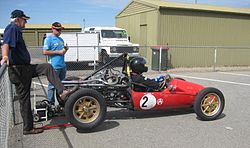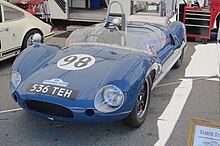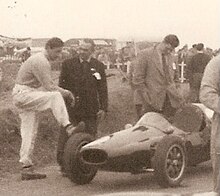Cooper Car Company
 | |
| Full name | Cooper Car Company |
|---|---|
| Base | Surbiton,Surrey,United Kingdom |
| Founder(s) | Charles Cooper John Cooper |
| Noted drivers | |
| Formula OneWorld Championship career | |
| First entry | 1950 Monaco Grand Prix |
| Races entered | 129 |
| Constructors' Championships | 2 (1959,1960) |
| Drivers' Championships | 2 (1959,1960) |
| Race victories | 16 |
| Pole positions | 11 |
| Fastest laps | 14 |
| Final entry | 1969 Monaco Grand Prix |











TheCooper Car Companywas a British car manufacturer founded in December 1947 byCharles Cooperand his sonJohn Cooper.Together with John's boyhood friend,Eric Brandon,they began by building racing cars in Charles's small garage inSurbiton,Surrey,England, in 1946. Through the 1950s and early 1960s they reachedmotor racing's highest levels as their mid-engined, single-seat cars competed in bothFormula Oneand theIndianapolis 500,and theirMini Cooperdominatedrally racing.The Cooper name lives on in the Cooper versions of theMiniproduction cars that are built in England, but is now owned and marketed byBMW.
Origins
[edit]

The first cars built by the Coopers were single-seat 500-ccFormula Threeracing cars driven by John Cooper and Eric Brandon, and powered by aJAPmotorcycleengine. Since materials were in short supply immediately afterWorld War II,the prototypes were constructed by joining two oldFiatTopolinofront-ends together.[1]According to John Cooper, the stroke of genius that would make the Coopers an automotive legend—the location of the engine behind the driver—was merely a practical matter at the time. As the car was powered by a motorcycle engine, they believed it was more convenient to have the engine in the back, driving a chain. In fact there was nothing new about 'mid' engined racing cars but there is no doubt Coopers led the way in popularising what was to become the dominant arrangement for racing cars. Called the Cooper 500, this car's success in hillclimbs and on track, including Eric winning the 500 race at one of the first postwar meetings atGransden Lodge Airfield,quickly created demand from other drivers (including, over the years,Stirling Moss,Peter Collins,Jim Russell,Ivor Bueb,Ken Tyrrell,andBernie Ecclestone) and led to the establishment of the Cooper Car Company to build more. The business grew by providing an inexpensive entry to motorsport for seemingly every aspiring young British driver, and the company became the world's first and largest postwar, specialist manufacturer of racing cars for sale toprivateers.
Cooper built up to 300 single-and twin-cylinder cars during the 1940s and 1950s,[2]and dominated the F3 category, winning 64 of 78 major races between 1951 and 1954. This volume of construction was unique and enabled the company to grow into the senior categories; With a modified Cooper 500 chassis, a T12 model, Cooper had its first taste of top-tier racing whenHarry Schellqualified for the1950 Monaco Grand Prix.Though Schell retired in the first lap, this marked the first appearance of a rear-engined racer at a Grand Prix event since the end of WWII.
The front-enginedFormula TwoCooper Bristol model was introduced in 1952. Various iterations of this design were driven by a number of legendary drivers – among themJuan Manuel FangioandMike Hawthorn– and furthered the company's growing reputation by appearing in Grand Prix races, which at the time were run to F2 regulations. Until the company began building rear-enginedsports carsin 1955, they really had not become aware of the benefits of having the engine behind the driver. Based on the 500-cc cars and powered by a modifiedCoventry Climaxfire-pump engine, these cars were called "Bobtails". With the centre of gravity closer to the middle of the car, they found it was less liable to spins and much more effective at putting the power down to the road, so they decided to build a single-seater version and began entering it in Formula 2 races.
Rear-engined revolution
[edit]Jack Brabhamraised some eyebrows when he took sixth place at the1957 Monaco Grand Prixin a rear-engined Formula 1 Cooper. When Stirling Moss won the1958 Argentine Grand Prixin Rob Walker's privately entered Cooper andMaurice Trintignantduplicated the feat in the next race at Monaco, the racing world was stunned and a rear-engined revolution had begun. The next year,1959,Brabham and the Cooper works team became the first to win the Formula One World Championship in a rear-engined car. Both team and driver repeated the feat in1960,and every World Champion since has been sitting in front of the engine.
The little-known designer behind the car wasOwen Maddock,who was employed by Cooper Car Company.[3]Maddock was known as 'The Beard' by his workmates, and 'Whiskers' to Charles Cooper. Maddock was a familiar figure in the drivers' paddock of the 1950s in open-neck shirt and woolly jumper and a prime force behind the rise of British racing cars to their dominant position in the 1960s. Describing how the revolutionary rear-engined Cooper chassis came to be, Maddock explained, "I'd done various schemes for the new car which I'd shown to Charlie Cooper. He kept saying 'Nah, Whiskers, that's not it, try again.' Finally, I got so fed up I sketched a frame in which every tube was bent, meant just as a joke. I showed it to Charlie and to my astonishment he grabbed it and said: 'That's it!'" Maddock later pioneered one of the first designs for a honeycomb monocoque stressed skin composite chassis, and helped develop Cooper's C5S racing gearbox.
Brabham took one of the championship-winning Cooper T53 "Lowlines" toIndianapolis Motor Speedwayfor a test in 1960, then entered the famous 500-mile race in a larger, longer, and offset car based on the 1960 F1 design, the unique Type T54. Arriving at the Speedway 5 May 1961, the "funny" little car from Europe was mocked by the other teams, but it ran as high as third and finished ninth. It took a few years, but the Indianapolis establishment gradually realized the writing was on the wall and the days of their front-engined roadsters were numbered. Beginning withJim Clark,who drove a rear-enginedLotusin 1965, every winner of the Indianapolis 500 since has had the engine in the back. The revolution begun by the little chain-driven Cooper 500 was complete.
Once every Formula car manufacturer began building mid-engined racers, the practicality and intelligent construction of Cooper's single-seaters was overtaken by more sophisticated technology fromLola,Lotus,BRM,andFerrari.The Cooper team's decline was accelerated when John Cooper was seriously injured in a road accident in 1963 driving a twin-engined Mini, and Charles Cooper died in 1964.
Final years
[edit]
After the death of his father, John Cooper sold the Cooper Formula One team to the Chipstead Motor Group in April 1965. The same year, the Formula One team moved from Surbiton to a modern factory unit at Canada Road, Oyster Lane in Byfleet, just along the road fromBrabhamin New Haw and close toAlan Mann Racing.Cooper's 1965 season petered out and at the end of the year, number one driverBruce McLarenleft to build his own F1 car for the new for 1966 3-litre formula. Cooper's new owners held theMaseraticoncession for the UK and arrangements were made for Cooper to build a new 3-litre Cooper-Maserati car which would be available for sale as well being raced by the works team. The Maserati engine was an updated and enlarged version of the 2.5-litre V-12 which had made sporadic appearances in the works250Fsin 1957. It was an old design, heavy and thirsty and the newCooper T81chassis built to take it was necessarily on the large side, in spite of which the bulky V-12 always looked as though it was spilling out of the back. Three cars were sold to private owners, one each toRob WalkerforJo Siffertto drive,Jo Bonnier's Anglo Swiss Racing Team, and French privateerGuy Ligier.None of these cars achieved much success.
Jochen Rindtwas entering the second year of his three-year contract, but with the departure of McLaren, Cooper had a seat to fill in the second car and with the team's recent lack of success, understandably, a large queue of potential drivers was not forming at Canada Road. In the circumstances, Cooper were fortunate to acquire the services of Honda'sRichie Ginther,who was temporarily unemployed due to the Japanese company's late development of their new 3-litre car. After a couple of races, Ginther was recalled byHondato commence testing of theirnew carand the American was no doubt more than somewhat chagrined to discover that it was even bigger and heavier than the Cooper. After making a one-off arrangement withChris Amon(unemployed due to the McLaren team's engine problems) to drive in theFrench Grand Prix,Cooper had an enormous stroke of luck whenJohn Surteesbecame available after falling out with Ferrari. Once conflicting fuel contract issues were resolved (Surtees was with Shell, Cooper with BP), Surtees joined the team. Cooper honoured its commitment to Amon, so three cars were run in the French GP. Subsequently, the team reverted to two entries for Surtees and Rindt and with the former Ferrari driver's development skills and a switch toFirestonetyres, the car was improved to the point that Surtees was able to win the final race of the year inMexico.
Surtees left to join Honda for 1967 andPedro Rodríguezjoined Rindt in the team and immediately won the opening race of 1967 inSouth Africain an unlikely Cooper one-two. This was a fortuitous win for Rodríguez, as he was being outpaced by RhodesianJohn Lovein his three-year-old ex McLaren Tasman Cooper powered by a 2.7-litreCoventry ClimaxFPF. Unfortunately, Love had to make a late pit stop for fuel and could only finish second. This was to be Cooper's last Grand Prix victory. The rest of the 1967 season had the team's fortunes steadily decline and the midseason appearance of the lighter and slimmerT86chassis failed to improve things. Rindt, impatiently seeing out his Cooper contract, deliberately blew up his increasingly antiquated Maserati engine in theUS Grand Prixand was fired before the season finale inMexico.
For 1968, Cooper would have liked to have joined the queue for theCosworth-Ford DFV,but felt that its connections toBritish Leylandwith theMini-Coopersmade this inadvisable. Instead, a deal was done withBRMfor the use of its 3-litre V-12, originally conceived as a sports car unit, but which BRM themselves would be using in 1968. A slightly modified version of the T86 was built for the new engine, dubbedT86Band Italian ex-Ferrari driverLudovico Scarfiottiand young EnglishmanBrian Redmanwere employed to drive it. The cars managed three-four finishes in theSpanishandMonacoGrands Prix, largely thanks to the unreliability of the competition, but then Scarfiotti was killed driving a Porsche in the Rossfeld hill climb and Redman had a big accident in theBelgian Grand Prixwhich put him out of action for several months. Cooper continued the season with a motley collection of drivers, none of whom could make anything of the outclassed T86B. During the season, Cooper built a modified chassis, the T86C, intended to take anAlfa Romeo3-litre V-8 but the project was stillborn.
The beginning of the end for the Cooper Car Company was in 1969, as it tried, and failed, to find sponsorship for a newCosworth DFV-powered car and there were many redundancies. Frank Boyles was the last to leave, since he was in charge of building customer cars and it had been hoped that some more F2 cars would be sold. Frank went on to design and build a Formula Ford car called the Oscar and also a series of Oval Circuit cars known as Fireballs. Driving the rear-engine version of this car, Frank won more than 200 races during a period up until 1975 in a car he had designed and raced himself. This record is believed to have never been beaten.
In all, Coopers participated in 129 Formula One World Championship events in nine years, winning 16 races.
Besides Formula One cars, Cooper offered a series ofFormula Juniorcars. These were theT52,T56,T59,and T67 models.Ken Tyrrellran a very successful team withJohn LoveandTony Maggsas his drivers. Following the demise of Formula Junior, Ken Tyrrell testedJackie Stewartin aFormula Threecar, a Cooper T72. This test at theGoodwood Circuitmarked the start of partnership which dominated motorsport later on.
John Cooper retired to the Sussex coast, where in 1971, he founded the garage business at Ferring, near Worthing. The garage sold Mini Cooper engine-tuning kits and performance parts.[4][5]
The garage was sold to Honda in 1986 and the business was moved to East Preston to convert Mini Coopers into race cars.
In October 2009, Mike Cooper, the son of John Cooper, launched Cooper Bikes, the bicycle division of the Cooper Car Company.[6]
Formula One results
[edit]Mini legacy
[edit]As the company's fortunes in Formula One declined, however, the John Cooper-conceivedMini– introduced in 1961 as a development of theAlec Issigonis-designedBritish Motor CorporationMiniwith a more powerful engine, new brakes, and a distinctive livery – continued to dominate insaloon carand rally races throughout the 1960s, winning many championships and the 1964, 1965, and 1967Monte Carlo rallies.
Several different Cooper-marked versions of the Mini and various Cooper conversion kits have been, and continue to be, marketed by various companies. The currentBMW MINI,in production since 2001, has Cooper and Cooper S models and a number ofJohn Cooper Workstuner packages.
Cooper garage
[edit]On 1 April 1968, John Cooper leased the building, 243 Ewell Road,[7][better source needed]to the Metropolitan Police and the local Traffic Division (V Victor) moved in. They would stay there for the next 25 years and 'TDV' would become one of the busier police garages. In August 1968, they were supplied with two Mini Coopers, index numbers PYT767F and PYT768F. The centre boss of the steering wheel was replaced by a speaker and microphone and a PTT transmitter switch, was added to the steering column. The vehicles were trialled for a number of months, but no orders were placed for other garages. The police subsequently moved out, and the building became aPorschedealership.
References
[edit]- Footnotes
- ^Edsall, Larry (23 March 2018)."Well-told tale of the first three Shelby Cobras".The ClassicCars.com Journal.Retrieved21 November2018.
- ^Wright, op cit
- ^"Racing car designer whose rear-mounted engine propelled Jack Brabham and Cooper's to victory in Formula 1".The Telegraph.3 August 2000.Archivedfrom the original on 12 January 2022.Retrieved14 May2012.
- ^"John Cooper".27 December 2000.Archivedfrom the original on 12 January 2022.Retrieved23 September2019– via www.telegraph.co.uk.
- ^"Famous dealership goes back to roots".The Argus.7 January 2004.Retrieved23 September2019.
- ^Jurries, Amy (11 October 2009)."Cooper Car Company Launches Cooper Bikes".The Gear Caster.Retrieved16 December2020.
- ^[1]TNF Tourist Guide to Former Premises
- Sources
- John Cooper Works
- John Cooper - A Very British Marque, A Very British Man
- John Cooper: The Man Who Beat Italia
- Cooper profile at The 500 Owners Association
- John Cooper (1977).The Grand Prix Carpetbaggers: The Autobiography of John Cooper.Doubleday.ISBN0-385-03081-9
- Cooper Cars,by Doug Nye, 1983, Osprey Publishing, 2003, Motorbooks International
External links
[edit]- Cooper Type Reference, www.race-cars.comArchived12 October 2018 at theWayback Machine
- Formula One constructors
- Formula One entrants
- 1947 establishments in England
- 1969 disestablishments in England
- Car manufacturers of the United Kingdom
- British auto racing teams
- British racecar constructors
- Formula Two constructors
- Auto racing teams established in 1947
- Auto racing teams disestablished in 1969
- Formula One World Constructors' Champions
- British Touring Car Championship teams
- 24 Hours of Le Mans teams
- Formula Three constructors
